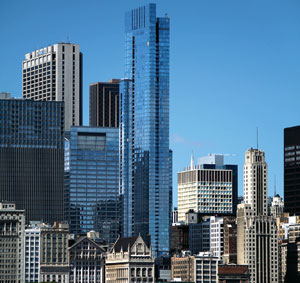A Chicago architect is producing a holistic planning approach to reduce carbon emissions in dense urban cores. The fledgling urban replanning effort, which Adrian Smith + Gordon Gill Architecture is developing for the 550-building Chicago Loop area, is a process that starts with a survey of existing buildings in a district to assess age, use, condition, energy consumption and more. The survey is a first step toward devising a district-wide approach to sustainable retrofits and appropriate adaptive reuse. The planning framework can be used as a model for retrofits in other cities, urban cores and building campuses, says the architect.
The goal of the firm’s Chicago Central Area Decarbonization Plan, which it is sponsoring with its own funds and with cooperation from the city and local organizations, is to improve the performance of every building and major infrastructure system within Chicago’s Loop. The idea is to reduce the area’s emissions of 3.9 million metric tons of carbon per year, to meet the goals of the 2030 Challenge.
The firm is still building its database, having surveyed 550 Loop buildings and interviewed 24 of 83 building managers. This is the start of a “monumental effort,” said Smith at the Council on Tall Buildings and Urban Habitat (CTBUH) 2009 conference on “Evolution of the Skyscraper: New Challenges in a World of Global Warming and Recession.” The conference was held Oct. 22-23 in Chicago and drew 613 people from 35 nations.
“If we want to make the biggest difference to the planet tomorrow, in terms of lessening the impact of building operations on climate change, then we need to concentrate on the upgrade of existing buildings,” added Antony Wood, the council’s executive director.
Though some attention at the conference was focused on energy retrofits, most was focused on new, planned or stalled tall buildings. According to CTBUH, there are at least 50 buildings taller than 158 m that have been on hold for some time after initiation of foundation work. Several projects, including the planned 1-kilometer-tall Nakheel Tower in Dubai and the planned 2,000-ft-tall Chicago Spire, were presented at the conference, prompting one attendee to redub the group, “the Council on Stalled Buildings.”
Eight of the tallest 20 stalled projects are in the Middle East, and six are in Latin America. Several are not out of the foundation phase, including Nakheel Tower. According to architect Woods Bagot, the tower’s foundations are half complete, but the building is on hold pending a revaluation by the developer sometime next year. In Chicago, foundations are complete for the Chicago Spire. Work also has stopped on the planned 1,047-ft-tall Waterview Tower. The partially complete frame stands as a conspicuous reminder of the recession.
Though the tall-building blahs have hit the Americas, Europe and many parts of the Middle East, the building boom in China “has not stopped,” said David Scott, a principal of the New York City office of engineer Arup. He was chairman of CTBUH until Oct. 22, when Sang-Dae Kim, a professor of structural engineering at Korea University in Seoul, took over for a two-year term.
Of the tallest 50 buildings on hold, there are only three in China. Of the 100 tallest buildings under construction, some 30 are in China.
The next likely skyscraper in China, in its early stages of construction, is the planned 632-m Shanghai Tower. The design calls for 128 stories of retail, exhibit, office and hotel space in what the design architect, Arthur Gensler, described as a vertical city of 5.5 million sq ft. Every 14 floors, at the skylobby levels, there are amenities, said Gensler, chairman of the San Francisco-based firm that bears his name.
The tower’s design, which is seeking a Gold certification from the LEED sustainable-building rating system, includes wind turbines for night lighting, rainwater collection and more.
Another sustainable tall building in China still under way is the Pearl River Tower in Guangzhou, planned at 310 m. Construction of the eventual 71-story building is at approximately level 40 for the main floors...





















Post a comment to this article
Report Abusive Comment